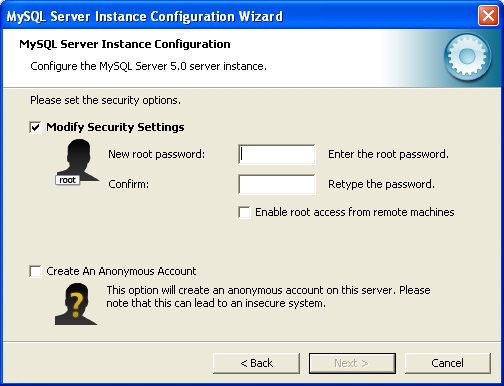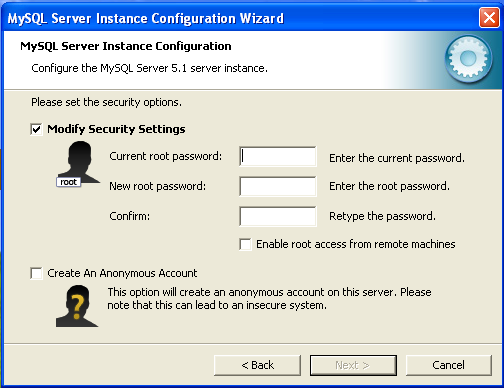- 2.3.4 MySQL Server Instance Configuration Wizard
- 2.3.4.1 Starting the MySQL Server Instance Configuration Wizard
- 2.3.4.2 Choosing a Maintenance Option
- 2.3.4.3 Choosing a Configuration Type
- 2.3.4.4 The Server Type Dialog
- 2.3.4.5 The Database Usage Dialog
- 2.3.4.6 The InnoDB Tablespace Dialog
- 2.3.4.7 The Concurrent Connections Dialog
- 2.3.4.8 The Networking and Strict Mode Options Dialog
- 2.3.4.9 The Character Set Dialog
- 2.3.4.10 The Service Options Dialog
- 2.3.4.11 The Security Options Dialog
- 2.3.4.12 The Confirmation Dialog
The content of the security options portion of the MySQL Server Instance Configuration Wizard will depend on whether this is a new installation, or modifying an existing installation.
-
Setting the root password for a new installation
It is strongly recommended that you set a
rootpassword for your MySQL server, and the MySQL Server Instance Config Wizard requires by default that you do so. If you do not wish to set arootpassword, uncheck the box next to the Modify Security Settings option.
-
To set the
rootpassword, enter the desired password into both the New root password and Confirm boxes.Setting the root password for an existing installation
If you are modifying the configuration of an existing configuration, or you are installing an upgrade and the MySQL Server Instance Configuration Wizard has detected an existing MySQL system, then you must enter the existing password for
rootbefore changing the configuration information.
If you want to change the current
rootpassword, enter the desired new password into both the New root password and Confirm boxes.
To allow root logins from across the
network, check the box next to the Enable root
access from remote machines option. This
decreases the security of your root
account.
To create an anonymous user account, check the box next to the Create An Anonymous Account option. Creating an anonymous account can decrease server security and cause login and permission difficulties. For this reason, it is not recommended.

User Comments
Is it me or does the screen shot not match the description here? I believe the screen states to check here in order to enable users to login from remote machines. The text of the manual seems to be stating the opposite.
Brian,
You are right. It's written here in the opposite way. I've emailed MySQL team about this.
This dialog screenshot does not match the actual installs screenshot which requests the current password. What is the current password ? root ?
David,
If prompted for a current pw, that is the pw associated with a previous installation.
If you don't rmemeber the root password from your previous installation, you have two options:
(1) Uninstall the current and all previous installations completely and then reinstall.
(2) Reset the root password using the method described in B.1.4.1.
Even if you uninstall MySQL completely on Windows, it will still remember the old password somehow and prompt you for it. The dialog will display "Modify Security Settings" and prompt you for the "current root password". If you enter the wrong old password, an error will result. I spent a while trying to fix this problems. On Windows 7, you need to delete the directory called: C:\ProgramData\Mysql. C:\ProgramData is actually hidden, so you might have had problems finding this. In any event, this will help you if you have forgotten the password to your MySQL root account.
After long hours installing MySQL 5.1 on Win XP and a couple of failures on the root password i finally install it.In the previous installations i do a root password that i forget.So everytime i try to re-install it prompts for the old password
Then i delete all the files of the previous installations making a search in Windows Explorer and a registry cleaning using CCleaner.
The last installation was then successfully.
After uninstalling the MySQL Server from Windows 7, you may also need to delete the MySQL folders from both the installation path and from c:\Users\[your Windows user name]\AppData\Roaming. Until I did that, the configuration wizard kept asking me for a password, even after I tried the above instructions.
Add your own comment.